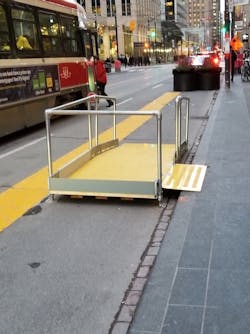Toronto installs temporary pedestrian ramps to improve transit accessibility
The city of Toronto, Canada, launched the King Street Transit Pilot Project in November 2017. The purpose of the project is to improve transit reliability, capacity and speed. Giving priority to streetcars, the project does not allow personal vehicles through certain intersections along King Street.
The city chose King Street for a pilot location because its surface transit route is the busiest in the city, at 65,000 daily riders. Only two subway lines have more riders. With 20,000 personal vehicles traveling King Street every day, transit riders suffered from slow and overcrowded streetcars. Because of traffic congestion, riders were subjected to unreliable streetcar schedules. Last, instead of driving, downtown Toronto residents prefer to walk, cycle or use transit by a 3:1 ratio.
As part of the study that led to the project itself, participants said the entire pilot area should be accessible for people with mobility issues or limited vision, and designers should include accessible and adequate space for streetcars to make pick-ups and drop-offs.
The transit stops, prior to the pilot launch, were accessible. They featured permanent curb ramps with tactile warning surfaces.
However, under the project plan, several stops would be moved to locations without permanent ramps or warning surfaces. In these new locations, if left as is, pedestrians with mobility issues or limited vision would be denied safe passage over the curbs, as well as access to streetcars. Also, without a temporary, accessible pathway, the city would not comply with legislative mandates, and they could be subjected to civil rights complaints.
To solve these safety and civil rights issues, the city decided to install temporary ramps. They first considered asphalt and metal ramps. Asphalt ramps, however, would not allow for rain runoff; rainwater would pool, and perhaps freeze, proving a safety hazard. Metal ramps would project too far into the road itself, and interfere with cyclists and streetcars.
The city decided to install PSS BoardWalk Temporary Pedestrian Modular Ramp and Platform at the new transit stop locations. BoardWalk Ramp provides accessible, detectable and safe guidance where access routes cross curbs. As the ramp and platform configuration is typically installed in the curb lane, parallel to traffic, it would not interfere with other traffic. Also, BoardWalk is designed to provide a 1:12 slope ratio, allowing rainwater to flow underneath.
As an example, the 514 Cherry streetcar now provides accessible service (see image below). Each new stop has a ramp from the sidewalk to the protected curb area.
Initial responses to the entire project seem favorable. Marcus Gee, Toronto columnist for The Globe and Mail newspaper, recently wrote:
“But, at least at first, the streetcar zone seems to be making a real difference. With planters on the road at stops and colorful barriers at intersections, the King car seems not just faster, but safer. This looks and feels like a real transit zone…”
Toronto’s King Street Transit Pilot Project will run through the end of 2018.
